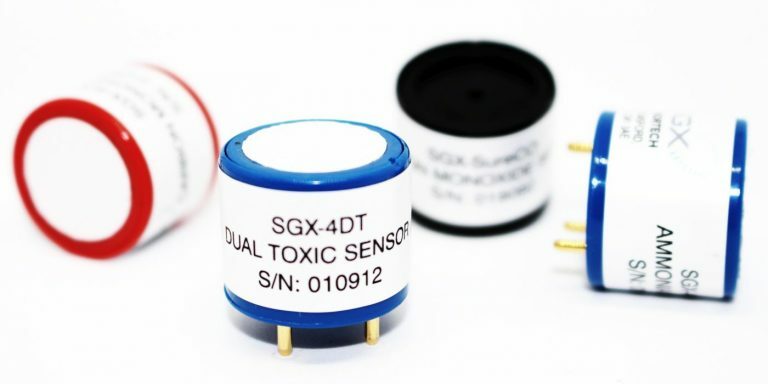Design engineers seeking to develop more sustainable devices can turn to electrochemical gas sensors for a variety of applications that reduce carbon emissions, protect the environment and safeguard human health.
The first step is understanding the development, characteristics and effects of electrochemical gas sensors. Next, work with a supplier-partner that can recommend the best application solution. One of those suppliers is SGX Sensortech, a division of Amphenol and the industrial leader in electrochemical gas sensors.
The emission of volatile organic compounds (VOCs) during industrial processes is a significant concern. These emissions degrade air quality, cause smog, intensify the greenhouse effect and contribute to climate change. One statistic underscores the seriousness of the problem: The World Health Organization reports air pollution causes 7 million premature deaths a year.
Electrochemical gas sensors offer wide application in many industries. Among them are automotive, mining, medical, oil & gas, petrochemical, indoor air quality and many others.
How can electrochemical gas sensors help?
Electrochemical gas sensors use the electrochemistry principle to identify and measure certain gases. These sensors have a sensing electrode, a counter electrode and a reference electrode. When the working electrode and the target gas come into contact, a chemical reaction generates a detectable electrical current. This current, proportional to the gas concentration, helps measure gas levels.
An electrochemical sensor consists of the following components:
- Gas permeable membrane:This material covers the sensing electrode and is used to control the amount of gas molecules reaching the electrode surface. The membrane also performs the important role of filtering unwanted particulates.
- Electrode (anode):To create an effective reaction with gas molecules, the electrode is typically made from metals such as platinum or gold and works as a transducer. The anode is the point at which the current enters the electrode.
- Electrode (cathode):This is the point where the current leaves the electrode.
- Electrolyte: The electrolyte facilitates the cell reaction and carries the ionic charge across the electrodes.

reaction between the gas and the oxygen contained in the sensor.
Electrochemical gas sensor applications
Electrochemical gas sensors are versatile because of their advanced technology, making them suitable for many applications, including:
- Industrial safety:To ensure workplace safety by detecting and monitoring hazardous gases such as carbon monoxide (CO), hydrogen sulphide (H2S), ammonia (NH3) and VOCs. The sensors are used to protect workers in the oil and gas, chemical, mining and construction industries, among others.
- Environmental monitoring:For environmental monitoring and pollution control. They measure ozone (O3), nitrogen dioxide (NO2), sulphur dioxide (SO2) and carbon dioxide (CO2). Air quality and emissions monitoring assesses pollution, complies with standards and reduces environmental damage.
- Indoor air quality:To assess air quality in buildings and homes. They can monitor CO, VOCs and other pollutants that affect human health and comfort. Monitoring interior air quality helps prevent sick building syndrome, identifies leaks and improves ventilation.
- Medical and healthcare:To monitor the concentration of gases like oxygen (O2). The sensors help ensure the proper delivery of gases and assist in patient monitoring.
- Personal safety devices:In portable personal safety devices such as gas detectors and wearable gas monitors. The devices are commonly used in confined spaces, mining operations and firefighting to provide real-time gas concentration readings and warn users of potentially harmful or explosive atmospheres.
- Leak detection:For detecting gas leaks in various settings, including industrial facilities, laboratories and residential areas.
- Laboratory and research:For gas analysis and monitoring in laboratories and research facilities.
SGX electrochemical sensors technology explained
SGX electrochemical sensors detect gases by initiating a chemical reaction between the gas and the oxygen contained in the sensor. This reaction generates a modest current that is proportional to the amount of gas present. In essence, the sensor is a form of fuel cell. Reactions take place on two electrodes, which when combined form the sensing process. These electrodes are made up of small porous polytetrafluoroethylene (PTFE) discs with a thin layer of catalytic metal placed on top.
To ensure an efficient reaction of the gas, it is necessary to limit the rate of diffusion of the target gas into the sensor by using a barrier. This is because the electrodes have a finite catalytic activity that may vary with time and temperature. The barrier is manifested as a minute aperture or capillary within the sensor housing, as shown below.
SGX electrochemical sensor benefits
Among the advantages offered by SGX electrochemical gas sensors:
- Wide range of gas detection: SGX offers a variety of electrochemical sensors designed to identify gases such as chlorine (Cl2), nitrogen dioxide (NO2), hydrogen sulphide (H2S), carbon monoxide (CO) and many more. Due to their adaptability, the sensors can be used across sectors and applications.
- High sensitivity and selectivity: SGX sensors exhibit high sensitivity, enabling them to detect even trace amounts of target gases accurately and prevent false alarms.
- Robust and long-lasting:SGX sensors are built to withstand harsh environmental conditions including moisture, temperature fluctuations and chemical exposure.
- Compact and integration friendly:Their compact form factor enables effortless integration into diverse devices and systems.
Conclusion
SGX electrochemical gas sensors are notable for their performance, cutting-edge technology, robustness, adherence to safety standards, energy efficiency and wide array of gas detection functionalities. They are appropriate for deployment in safety and mission-critical use cases where precise, reliable gas detection is required to safeguard lives, avert mishaps and uphold operational soundness.

